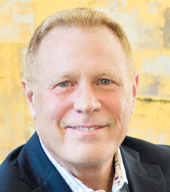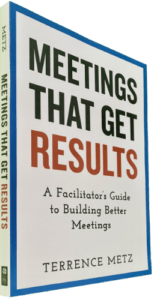“Contrary to popular opinion, you don’t need weird shoes or a black turtleneck to be a design thinker . . .” so goes the article from Harvard Business Review♦. The author suggests five characteristics found in design thinkers (i.e., innovators) that relate directly to the core competencies required for effective facilitation. Included (in alphabetical order) are Collaboration, Empathy, Experimentalism, Integrative Thinking, and Optimism.
 Design Thinker: Collaboration
Design Thinker: Collaboration
The increasing complexity of options and decision-making demands the involvement of many, rather than one. Lone genius has been replaced with cross-disciplinary subject matter experts. Select subject matter experts have the talent to succeed, the initiative, and the motivation to succeed, but frequently do not know how to succeed in a group setting. Many are subject matters across disciplines with experience drawn upon multiple backgrounds and organizations. At IDEO for example, they engage engineers, marketers, anthropologists, industrial designers, architects, and psychologists, among others.
Design Thinker: Empathy
Understanding that there is more than one right answer, seeking the best among multiple perspectives lends itself to creating an answer that did not walk into the meeting; but rather one that is created during the meeting. To support creation, empathy in the form of active listening with a neutral session leader becomes critical.
Design Thinker: Experimentalism
Challenging subject matter experts to make their thinking visible, from the heart, can advance the rationale behind their thoughts that breed both consensual understanding and breakthrough solutions. Through observation and questioning, session leaders can inspire and transfer ownership of the meeting output.
Design Thinker: Integrative Thinking
While analytical methods are certainly helpful, integrative approaches support innovation. A neutral facilitator can help a group understand multiple perspectives and build a solution(s) to reconcile seemingly contradictory points of view. For example, one participant may prefer black and another prefers white. Instead of viewing them as opposing thoughts, how can we integrate both black and white? Immediate answers include options such as two-tone, plaid, polka dot, shades of grey, etc.
Design Thinker: Optimism
Successful session leaders rely on confidence in method rather than expertise around content to generate higher quality solutions. Practically speaking, however, optimism and confidence come from experience, so don’t forget to try, practice, and some more. There is usually more than one right answer. You may not be the best facilitator in the world, but you are the best facilitator your group can find.
Trust that in the role of session leader, they need you more than anything else, to lead with Collaboration, Empathy, Experimentalism, Integrative Thinking, and Optimism. With this technique, you can open the doors of perception that make it easier for your group to develop breakthrough solutions.
~~~~~~~
♦ June 2008 (pg 87)
______
Don’t ruin your career by hosting bad meetings. Sign up for a workshop or send this to someone who should. MGRUSH workshops focus on meeting design and practice. Each person practices tools, methods, and activities every day during the week. Therefore, while some call this immersion, we call it the road to building high-value facilitation skills.
Our workshops also provide a superb way to earn up to 40 SEUs from the Scrum Alliance, 40 CDUs from IIBA, 40 Continuous Learning Points (CLPs) based on Federal Acquisition Certification Continuous Professional Learning Requirements using Training and Education activities, 40 Professional Development Units (PDUs) from SAVE International, as well as 4.0 CEUs for other professions. (See workshop and Reference Manual descriptions for details.)
Want a free 10-minute break timer? Sign up for our once-monthly newsletter HERE and receive a timer along with four other of our favorite facilitation tools, free.

Terrence Metz, president of MG RUSH Facilitation Training, was just 22-years-old and working as a Sales Engineer at Honeywell when he recognized a widespread problem—most meetings were ineffective and poorly led, wasting both time and company resources. However, he also observed meetings that worked. What set them apart? A well-prepared leader who structured the session to ensure participants contributed meaningfully and achieved clear outcomes.
Throughout his career, Metz, who earned an MBA from Kellogg (Northwestern University) experienced and also trained in various facilitation techniques. In 2004, he purchased MG RUSH where he shifted his focus toward improving established meeting designs and building a curriculum that would teach others how to lead, facilitate, and structure meetings that drive results. His expertise in training world-class facilitators led to the 2020 publication of Meetings That Get Results: A Guide to Building Better Meetings, a comprehensive resource on effectively building consensus.
Grounded in the principle that “nobody is smarter than everybody,” the book details the why, what, and how of building consensus when making decisions, planning, and solving problems. Along with a Participant’s Guide and supplemental workshops, it supports learning from foundational awareness to professional certification.
Metz’s first book, Change or Die: A Business Process Improvement Manual, tackled the challenges of process optimization. His upcoming book, Catalyst: Facilitating Innovation, focuses on meetings and workshops that don’t simply end when time runs out but conclude with actionable next steps and clear assignments—ensuring progress beyond discussions and ideas.



